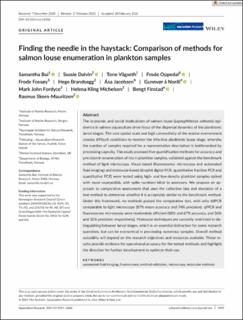| dc.contributor.author | Bui, Samantha | |
| dc.contributor.author | Dalvin, Sussie | |
| dc.contributor.author | Vågseth, Tone | |
| dc.contributor.author | Oppedal, Frode | |
| dc.contributor.author | Fossøy, Frode | |
| dc.contributor.author | Brandsegg, Hege | |
| dc.contributor.author | Jacobsen, Ása | |
| dc.contributor.author | Nordi, Gunnvør á | |
| dc.contributor.author | Fordyce, Mark | |
| dc.contributor.author | Michelsen, Helena Kling | |
| dc.contributor.author | Finstad, Bengt | |
| dc.contributor.author | Skern-Mauritzen, Rasmus | |
| dc.date.accessioned | 2021-11-04T13:11:42Z | |
| dc.date.available | 2021-11-04T13:11:42Z | |
| dc.date.created | 2021-03-08T08:36:13Z | |
| dc.date.issued | 2021 | |
| dc.identifier.citation | Aquaculture Research. 2021, . | en_US |
| dc.identifier.issn | 1355-557X | |
| dc.identifier.uri | https://hdl.handle.net/11250/2827928 | |
| dc.description.abstract | The economic and social implications of salmon louse (Lepeophtheirus salmonis) epidemics in salmon aquaculture drive focus of the dispersal dynamics of the planktonic larval stages. The vast spatial scale and high connectivity of the marine environment creates difficult conditions to monitor the infective planktonic louse stage, whereby the number of samples required for a representative description is bottlenecked by processing capacity. This study assessed five quantification methods for accuracy and precision in enumeration of lice in plankton samples, validated against the benchmark method of light microscopy. Visual-based (fluorescence microscopy and automated fluid imaging) and molecular-based (droplet digital PCR, quantitative fraction PCR and quantitative PCR) were tested using high- and low-density plankton samples spiked with louse copepodids, with spike numbers blind to assessors. We propose an approach to comparative assessment that uses the collective bias and deviation of a test method to determine whether it is acceptably similar to the benchmark method. Under this framework, no methods passed the comparative test, with only ddPCR comparable to light microscopy (87% mean accuracy and 74% precision). qfPCR and fluorescence microscopy were moderately efficient (88% and 67% accuracy, and 36% and 52% precision respectively). Molecular techniques are currently restricted in distinguishing between larval stages, which is an essential distinction for some research questions, but can be economical in processing numerous samples. Overall method suitability will depend on the research objectives and resources available. These results provide evidence for operational accuracy for the tested methods and highlight the direction for further development to optimize their use. | en_US |
| dc.language.iso | eng | en_US |
| dc.publisher | Wiley | en_US |
| dc.rights | Attribution-NonCommercial-NoDerivatives 4.0 Internasjonal | * |
| dc.rights.uri | http://creativecommons.org/licenses/by-nc-nd/4.0/deed.no | * |
| dc.title | Finding the needle in the haystack: Comparison of methods for salmon louse enumeration in plankton samples | en_US |
| dc.type | Peer reviewed | en_US |
| dc.type | Journal article | en_US |
| dc.description.version | publishedVersion | en_US |
| dc.source.pagenumber | 14 | en_US |
| dc.source.journal | Aquaculture Research | en_US |
| dc.identifier.doi | 10.1111/are.15202 | |
| dc.identifier.cristin | 1896230 | |
| dc.relation.project | Norges forskningsråd: 254718 | en_US |
| dc.relation.project | Norges forskningsråd: 244439 | en_US |
| cristin.ispublished | true | |
| cristin.fulltext | original | |
| cristin.qualitycode | 1 | |

